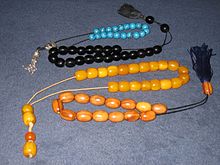Komboloi
As Komboloi or Koboloi ( Greek Κομπολόι [kɔ (m) bɔlɔi] , majority Κομπολόγια Ko (m) bologia to κόμπος combos "nodes") are called in Greece small chain of beads that are strung on leather or synthetic threads. Depending on the design, the beads are made of wood, plastic, metal, glass or amber, but also of minerals such as turquoise.
meaning
The Komboloi is a personal item in men's outfits. It serves as finger play, pastime, and occasionally as a meditation aid . Sometimes specimens are also viewed as personal lucky charms. The luck symbolism is derived from the knot that holds the chain together: This is an old luck symbol .
The komboloi in Greece no longer has any religious significance. Although the Kombológia are sometimes referred to as "Orthodox rosaries" , this term fits better on the so-called prayer cords of the Orthodox, called Komboskini in Greek . However, these do not contain pearls, but are simple cords with a corresponding number of knots.
origin
The komboloi originally comes from India or China ( Mala ); from there it reached the Arab world, where it became a prayer chain ( tasbih ) in Islam , in which each of the 99 pearls stands for one of the 99 names of Allah . Saint Dominic introduced it into the Christian world, from which the rosary later developed; Pope Gregory XIII 1573 introduced the feast of the Rosary on the first Sunday in October.
In Nafplio Aris Evangelinos runs a small Komboloi museum, in which prayer chains and their profane forms from the traditions of the Hindus , Buddhists , Muslims , Catholics and of course the Greeks and other Orthodox are collected and exhibited.

